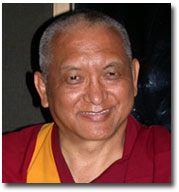

Tibetan: Gelugpa Sect
Lama Zopa Thubten Rinpoche
Organisation: FPMT
The Foundation for the Preservation of the Mahayana Tradition
The FPMT is an organization devoted to the transmission of the Mahayana Buddhist tradition and values worldwide through teaching, meditation and community service. There are 132 FPMT centers and projects worldwide as of December 2001. FPMT currently has four standard Buddhist education programs that are taught in many of the centers. Two of these, the Masters Program and the Basic Program are committed courses of 7 and 5 years of study respectively. Based on the great philosophical texts studied in the monasteries of Tibet, FPMT holds to rigid standards of translation and has a passion for authentic texts to ensure that complete accuracy of the meaning found within these profound texts is not forfeited in the transmission from East to West.
Lineage:Gelugpa: Geshe Rabten Rinpoche and Lama Thubten Yeshe.
Biography: Lama Zopa Rinpoche, the spiritual director of The Foundation for the Preservation of the Mahayana Tradition, is the reincarnation of the Sherpa Nyingma yogi Kunsang Yeshe, the Lawudo Lama. Rinpoche was born in 1946 in Thami, not far from the cave Lawudo, in the Mount Everest region of Nepal, where his predecessor meditated for the last twenty years of his life. While his predecessor had belonged to the Sakya tradition of Tibetan Buddhism, the Lawudo Lama himself had been a great master of the complete tantric teachings of the Nyingma tradition.
Rinpoche left Thami when he was about 4 years old and was put in a Monastery that was very close to the border of Nepal and Tibet. Rinpoche stayed at this Monastery for several years until he went to Tibet and took getsul ordination in 1958, and continued his studies in Domo Geshe’s monastery in Phagri, Tibet.
In 1959 Rinpoche escaped from Tibet and continued his studies in Sera Jhe monastery in Buxa Duar, in the north of India. This is where the Indian Government housed the monks from Sera, Ganden and Drepung Monasteries who wanted to continue their studies, along with monks from the other sects. It was at Buxa Duar that Rinpoche became the disciple of Geshe Rabten Rinpoche and then of Lama Thubten Yeshe. Frida Bedi then invited him to join her school for incarnate lamas in Dalhousie where they were given the chance to learn English for 6 months. Upon the completion returned to Buxa Duar and his studies. Lama Yeshe and Zopa Rinpoche’s contact with Westerners began in 1965 in Darjeeling. When they met Princess Zina Rachevsky from Russia. She became the Lamas first Western student. In 1969 they founded the Nepal Mahayana Gompa Center at Kopan, above Boudhnath Stupa in Kathmandu, Nepal.
At the insistence of Zina Rachevsky the Lamas started to teach courses on Buddhism for Westerns at Kopan. In 1971 Rinpoche took gelong ordination from His Holiness Ling Rinpoche in Bodh Gaya. By 1975, twelve centers had started. In 1976, the growing worldwide organization was named by Lama Yeshe ‘the Foundation for the Preservation of the Mahayana Tradition’ (FPMT).
Lama Zopa Rinpoche has many other projects around the world; one of the most important is the 500ft Maitreya Statue that Rinpoche is building in Bodh Gaya that will include schools, hospitals and other social projects such as Leprosy clinics (these social projects are already in existence and have been functioning for the last 15 years). Someof the other projects that Rinpoche has are Sera Jhe food fund – which offers food, breakfast lunch and dinner everyday to 2500 monks. The Lama Tsong Khapa teacher fund offers an allowance to the main 100 teachers in the Gelugpa tradition from various monasteries. Rinpoche also has a number of other funds that are for building holy objects, such as Stupas, prayer wheels etc. Rinpoche has a very strong interest in collecting texts from all the different traditions.
Main Centre:
FPMT International Office
1632 SE 11th Ave
Portland, OR 97214, USA
Website: www.fpmt.org
Tel: 1 503 808 1588
Fax: 1 503 808 1589
FPMT now has 144 study groups, centers and projects worldwide
Directory of FPMT Centres: www.fpmt.org/centers
All FPMT centers and study groups welcome students, visitors and enquiries. Select centers offer Retreat Facilities. Some are more active in Community Services. The Monasteries and Nunneries of the FPMT provide opportunities to train as a monk or nun.
• Main Web site: www.fpmt.org
Books/Publications:
MANDALA is a Tibetan Buddhist Journal that captures the life and times of a vibrant organization flourishing in 31 countries. It is published six times a year in February, April, June, August, October and December by the Foundation for the Preservation of the Mahayana Tradition.
MANDALA’s editorial policy is to always convey the power and relevance of the Buddha’s teachings. “We offer people what we have,” said Lama Thubten Yeshe, one of the founders of FPMT, “that is, the combined knowledge of Buddha’s teachings and the modern way of life.”
Website: www.mandalamagazine.org
Books by Lama Yeshe and Lama Zopa
Website: www.lamayeshe.com

